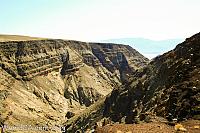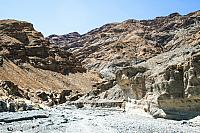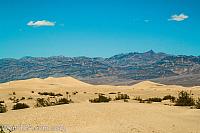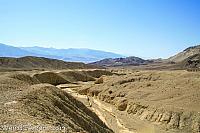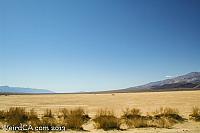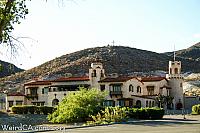Lost Treasures of Death Valley
 Death Valley, California
Death Valley, California
If you believe the legends and tall tales, gold, silver, and other treasures have been discovered time and time again in the harsh environment of Death Valley. And almost as many times, the location of the mine, gold, treasure has been lost. Here are just a few of the amazing tales of lost treasure in Death Valley!
The Jayhawkers
The Jayhawkers were several men most of who came from Knox County, Illinois in 1849. One man, named Thomas Shannon in the stories, brought with him $6,000 in gold coins, carried by the wagons with them. But when they ended up in Death Valley, near a place the Jayhawkers called Snow Camp, their animals died and they were forced to abandon the wagons, and thus all the gold with them. The story tells how Shannon offered half his gold to anyone who would carry it, but he had no takers, so the entire expedition pooled their possessions and buried it all in Death Valley with the intention of one day returning to claim it. One member of the party, a James B. Rood did try and return to claim the treasure, but was unable to locate it, believing that it had perhaps been washed away by storms.
Burnt Wagons
Six or seven Mormon wagons were crossing Death Valley in September 1849, when they set up camp roughly seven miles northwest of what is today, Death Valley Junction (home of Amargosa Opera House). During the night, Native Americans attacked the camp site and not only were the horses lost, but also a jeweler from Missouri who was one of the travelers was killed. The jeweler had intended to set up a new jewelry store in California and thus was traveling with a large amount of cash, plus jewelry and even watches. Without horses, the party had to abandon the wagons, so they dug two holes, and in one they buried the jeweler and in the other they buried his possessions including the cash and jewelry. They move the wagons over the holes and set them on fire in order to mark the location. The location is now known as Burnt Wagons and is California Historical Landmark #441. The historical plaque can be located at Stovepipe Wells in Death Valley. The plaque is located in front of an old historic fire truck.
Burned Wagons Point
Near this monument, the Jayhawker group of Death Valley Forty-Niners, gold seekers from Middle West, who entered Death Valley in 1849 seeking short route to the mines of central California, burned their wagons, dried the meat of some oxen and, with surviving animals, struggled westward on foot.
State Registered Landmark No. 441
Marker Placed by California Centennials Commission Base Furnished by Death Valley 49ers Inc. Dedicated December 3, 1949
Lost Gunsight Mine
Near what is today called White Sage Flats, lies a lost lode of silver! In the winter of 1849 / 1850 a group now referred to as the Death Valley Forty Niners attempted to cross Death Valley. Four members including a Captain Towne and a James Martin split off from the main group on December 29th 1849, and decided to try and directly cross the Panamint Mountains. They spent three days lost in the areas around Tucki Mountain. While searching for a way through, Captain Towne accidentally hit his rifle against some rocks, knocking off the gun sight. While hopelessly searching for the fallen gun sight, he instead found silver. Little silver rocks were all over, having fallen from a high ledge. The party made note of it, continued on, and reached civilization. They showed off their silver, word got around, and thus began a search for that ledge of silver that has lasted over a century! To this day, no one has located that silver lode somewhere near Tucki Mountain.
Lost Gold of the Black Sands
This tragic tale involves two Paiute Native American brothers who, while resting in a cave high up in the Funeral Mountains along the Eastern edge of Death Valley, not far from where the town of Chloride was, they discovered an area of the cave with cool air emerging. So they, of course, investigated, going down a narrow tunnel and emerging in a large, domed cavern with an underground pool. The banks of the pool were covered in black sand rich with gold deposits. The two collected as much as they could carry, and came back the very next day. But on the second trip, one of the brothers began to swim out to a small island in the middle of the pool. Horribly, the water was suddenly sucked out of the pool by the current, the force of the action dragging the poor brother with it, drowning him. As a result the brother never returned to the cave that had taken his brother, and as is tribal tradition, the Native Americans refused to go there, nor would they give out any directions to anyone else.
Alvord's Lost Mine
Sometime during the spring of 1861, a sixty year old man from New York named Charles Alvord went in search of the previously mentioned Lost Gunsight Mine with Asabel Bennett, Joe Clews, and three other gentleman. They were known as "the Mormons" and they entered the southern end of Death Valley with several mules and wagons. There have been rumors that Alvord was part of the original Death Valley Forty-Niners, but that has never been proven, and it is believed that Alvord had little knowledge of prospecting.
While the party was camped near Saratoga Springs in the southern part of Ibex Hills, Alvord went off on his own, exploring the Panamint Mountains on his own for two weeks. He returned with some black ore that had supposedly been discovered near a striped butte within the Panamint Mountains. His fellow prospectors sneered at his find, not believing it to be gold, and were far more interested in the fact that Bennett had possibly discovered silver. When the ores were assayed later in Los Angeles, Bennett's was found to be just lead, while Alvord's was manganese and very rich in gold.
What followed was several mishap expeditions, lots of betrayal and deceipt, and eventually murder, with Alvord not being too good at picking those he traveled with, as he was stranded and left in Death Valley, not just once, but twice. Even worse, Bennett literally abandoned him out in the desert both of those times, with the first time Bennett feeling guilty and eventually going back for him.
Unfortunately, it was not Death Valley, itself, that would do Charles Alvord in, but a man known only as Jackson, who while the two were off prospecting for coal in Kern County, murdered Alvord for his equipment and belongings. Jackson had been part of a party that had saved Alvord the second time he had been stranded in Death Valley.
Alvord's lost ledge of gold is still missing. It is possibly in the southwestern corner of Death Valley, in the Panamint Mountains, near a striped butte, perhaps the one that Butte Valley is named after.
Lost Breyfogle Mine
In 1862, Charles C. Breyfogle emerged out of the Armagosa Desert, arriving at Baxter Springs, half dead, and having traveled 250 miles from the Panamint Mountains, across Death Valley and the Funeral Range. But he carried with him in his bandanna, gold nuggets that were of extremely high quality from what Breyfogle described as the richest vein he had ever seen. This led to perhaps the most famous lost mine story to ever be told for the area.
How did Breyfogle end up with these gold nuggets? Along with two other prospectors, McLeod and O'Bannion, the three had set off to look for gold one spring near the eastern edge of the Panamint Mountains. One night they were unfortunately set upon by Native Americans. McLeod and O'Bannion were killed, but Breyfogle, as was his habit, was sleeping some distance from the other two prospectors and awoke in time to grab his shoes and escape barefoot.
Breyfogle had fled east into Death Valley. Eventually, possibly somewhere near the west side of the Funeral Range, he discovered a spring with some alkaline water, which of course he drank, making him sick. Soon after he found a green tree, which he headed to looking for fresh water. He instead found hundreds of gold flecked stones, some of which he gathered up in his bandanna. With the gold flecked stones, a short distance away he found the rich two foot thick vein of gold that was the source. It went up the mountain as far as he could see.
The tree turned out to be a mesquite tree, which Breyfogle ate from, and half crazed, and ever so thirsty somehow found his way over the Funeral Range, through the Armagosa Desert and into Baxter Springs where a rancher found him.
For five years after, Breyfogle, along with others, searched for the lost gold, but were unable to relocate it. One theory states that a landslide may have covered up the vein. Even later, George Hearst, father of William Randolph Hearst, searched for the treasure for nearly eighteen months, failing to find it.
Some rumors instead place the missing mine and gold in southwestern Nevada. In the 1930s, an old prospector named Roscoe Wright discovered an unusual rock formation in the Nevada desert. East of the town of Beatty in what is called Forty Mile Canyon, a strange rock bore the inscription "BY FOGLE 1863". Theories stated that maybe in his thirst and delirium, Charles Breyfogle marked the location of his find, by inscribing on the rock. No gold has been found around the rock though, and any future efforts are extremely hindered by the fact that the land eventually became part of the Las Vegas Bombing and Gunnery Range. This on December 12th, 1950 was selected as a nuclear test site, eventually leading to the land around the rock to be part of the Nevada Test Site and later the Nevada National Security Site, meaning not only were nuclear bombs tested on the land, only authorized people are allowed anywhere near the rock.
Six Springs Canyon Gold
In the mid 1880s (somewhere between 1884 and 1888), an ill and weary Chinese man wandered in from the desert near Searles Lake and collapsed at the feet of John Searles (yes, I believe the lake is named after him). Searles Lake is southwest of Death Valley over by Trona. The poor Chinese man had been subject to cruel treatment at the Harmony Borax Works, and left, walking towards the Mojave, he had made it as far as the lake. The Chinese man's hope was that if he died he could have someone in the Mojave arrange the transport of his body back to China. John Searles asked his foreman, Bill Parkinson, to take the sick man the rest of the way to the Mojave.
Native Americans had given the Chinese man a shortcut through the Panamint Mountains, one that took him through the Six Spring Canyon area, east of Ballarat. There the man had found a great deal of ore rich in gold. He had picked up a few of the nuggets and in thanks, gave Parkinson one on their trip to the Mojave, telling him where he had found them.
The man unfortunately passed away shortly after arriving at Mojave, before Parkinson even had time to leave town to head back to Searles Lake. John Searles and Bill Parkinson tried several times to locate the gold, but never found it.
Akali Jones and the Golden Eagle Mine
in 1902 Alkali Jones decided that he wasn't going to ever make his fortune in the small town of Skidoo in Death Valley. So he packed up his burro and headed east, intending to relocate to Searchlight, Nevada and hopefully strike it rich there. But while crossing the harsh desert of Death Valley, he was caught in a sandstorm and had to seek shelter. He hid in a grouping of some large granite rocks and waited out the sandstorm.
After the storm cleared, Alkali found it necessary to scout out his environs and thus climbed a butte to look around. However, while climbing up the north side of the butte he discovered a vein of quartz that was about three feet wide and completely shot through with gold. He spent a couple of hours collecting some of the gold, during which he looked up, saw a large bird, and believing it to be an omen, dubbed the find the Golden Eagle Mine. He wrote out a description of the area along with a claim to the area, stuffed it in a tobacco can and buried the can under some rocks in order to lay claim to the gold he had found.
Akali continued on, now out of water, and eventually emerged from the desert at Coffin Mountain located in the Black Mountains near the Funeral Range (Death Valley is very colorful in its naming conventions). Akali put together a crude map, was able to locate water, and then several days later finally made it to Searchlight, Nevada.
In Searchlight, Akali cashed in the gold he had found discovering it to be very rich. With his new found money he purchased more burros and supplies intending to head back to his claim and mine for more gold. It's said that he talked often while in Searchlight of his find, freely discussing his miraculous find and even showing people his map. Soon he set back out to find his Golden Eagle Mine. He was last seen in Goodsprings, before disappearing forever. Did he find his mine again and retire rich somewhere? Or is it more likely that someone who he told the tale of his new found gold, followed him into the desert and murdered him?
Of course the tale continues. In 1912, supposedly two Shoshone Native Americans came to Panamint Springs claiming to have found an old pack out in the desert, the contents of which supposedly belonged to Akali Jones. About a year later, in the same area where the Shoshone discovered the lost pack, a prospector discovered human bones. It was impossible to determine who the bones belonged to or how the victim had died.
Lastly in 1945 a geologist by the name of Simmons is said to have finally located Akali Jones's tobacco can. Although the paper inside it was completely faded, Simmons was positive that he was in the area of the lost mine. But the entire area was completely covered by fresh sand dunes, having been blown around by the harsh and powerful winds of the desert.
Alkali Jones probably never made it back to his amazing vein of gold, most likely perishing in the cruel desert of Death Valley. In 1906, less than four years after he left Skidoo, gold was found in the region of the small settlement.
Lost Chicken Bones Mine
In the early 1900s, a prospector named Charles Wilson brought in several sacks of ore samples to an assayer at the Red Dog Custom Mill in Johannesburg. Wilson then left for Los Angeles telling the assayer he'd back in a couple of weeks. The assayer ignored the gold until one day his wife threw one of the nuggets into the pile of garbage with some chicken bones. The bones supposedly acted as a reagent with the ore and separated out the gold when the garbage was lit on fire. The assayer discovered that the ore was rich with pure gold. He rushed off to Los Angeles to find Wilson, who had unfortunately been run over by a streetcar. The assayer spent six full months trying to locate the ledge that had produced the gold laden ore, which according to Wilson was somewhere northeast of Ballarat, near Surprise Canyon in the Panamint Mountains. The lost gold mine is now colorfully referred to as the Lost Chicken Bones Mine.
Lost Shorty Harris Mine
Standing all of 5'4", Shorty Harris was a famous and well regarded prospector hanging out in Death Valley. Born Frank Harris on July 21st, 1857 in Rhode Island, Shorty's word was well respected and he had several successful strikes, although he usually blew all the money on celebrating and drinking with his buddies after. Some say he could smell gold. One day while traveling back from the floor of Death Valley, while passing through a canyon, on the way to Skidoo, Shorty discovered a rich ledge of gold, he claimed one of the richest he'd ever discovered. He marked the ledge so he could find it again, putting his pick into it. But, as was Shorty's way, when he got back to town, he went out celebrating, drank way too much, and in the morning, when he woke up, completely forgot which canyon he had left his pick in.
Shorty Harris stayed around Death Valley still looking for gold until he was in his seventies. Before being in Death Valley he looked for and found gold in Nevada in Goldfield and Rhyolite. There's a statue at the Goldwell Open Air Museum in front of Rhyolite of a prospector and a penguin. This is supposedly Shorty Harris, who when he drank too much would apparently see penguins following him around. The statue was made in 1994 by Fred Bervoets. Shorty was 77 when he passed away in 1934 and is buried in Death Valley next to Jim Dayton. Their grave site can be found along West Side Road, which runs parallel and west of Badwater Road and Badwater Basin. This might make Shorty Harris's gravesite the lowest gravesite in the United States.
Scotty's Castle
Some myths claim that Death Valley Scotty actually did discover gold, and that before he died in the 1950s he buried it around "his" castle at Death Valley Ranch. Despite in 1941 a federal judge claiming Scott's treasure and gold mines was all a myth, stories of his treasure still occasionally persist. Scotty who conned several investors into backing fictitious mining operations is still getting a last laugh over the gullible.
Follow WeirdNV.com!
Closest Weird
Wildrose Charcoal Kilns
25.12 Miles Away
Death Valley, California
Devil's Golf Course
(Devil's Golf Course)
28.39 Miles Away
Death Valley, California
Keeler
41.06 Miles Away
Keeler, California
Outside References:
- Lost Gold and Silver Mines of the Southwest (1996) by Conrotto, Eugene L, p: 26 - 27, 48 - 50, 86 - 88
- Buried Treasures of California (1995) by Jameson, W.C., p: 51 - 108
- Little Known Tales in California History (1997) by Pryor, Alton, p: 141 - 145
First Created: 2020-07-01
Last Edited: 2020-07-01



